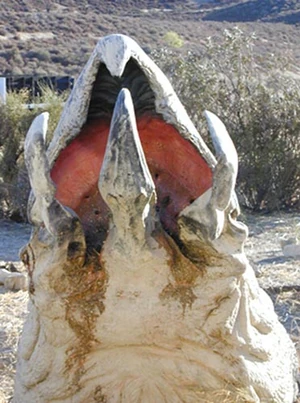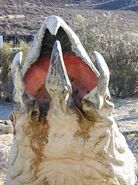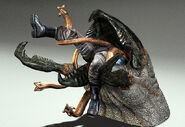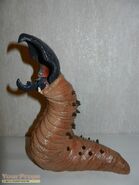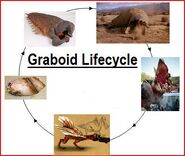| ||||||||||||||
| [Source] | ||||||||||||||
The Graboid, (also known as the Dirt Dragon or Tu Lung in the 19th century), is a fictional invertebrate species that is the primary antagonist of the Tremors franchise. The creature made its debut in the 1990 film Tremors, and reappeared in all its sequels Tremors 2: Aftershocks (1996), Tremors 3: Back to Perfection (2001), and prequel Tremors 4: The Legend Begins (2004). It was also featured regularly in the series' spin-off Tremors: The Series (2003), with El Blanco being a recurring character. A variant was featured in the 2015 film Tremors 5: Bloodlines and Tremors: A Cold Day in Hell
Life Cycle[]
It seems that considering the information presented in the movies this entire life cycle can take place in about 9 months, however due to the eggs ability to hibernate for extended periods of time this is likely the reason that the creatures were virtually unknown up until the late 20th century. The 4th Tremors movie is the first chronological reappearance of the Graboids, it begins a time when Grabboid pockets are reawakened all over the world as suspected by scientists (according to Burt).
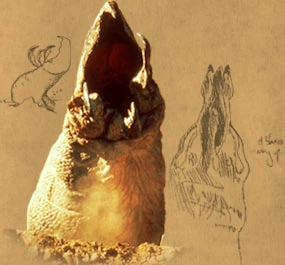
Graboid's picture from Scifi.com
Graboids' Eggs[]
These are laid by Ass Blasters
Dirt Dragons[]
Dirt Dragons are the baby Graboids from Tremors 4, also known as Dirt Dragons and Tu-Long. So far they have only appeared in Tremors 4.
Graboid[]
The standard Graboid is the only creature to have appeared in all four entries, and also the 2003 TV series of the same name. There are two known species: one in North America and the other in Africa. in both species, the Graboid is the first stage in the creatures' life cycle. In Tremors 4: The Legend Begins, which is a prequel taking place in 1889, thus before they got their current name, they are referred to as "dirt dragons". The name "Grabboid" was invented by the shop owner character in the first film, Tremors, Walter Chang; who was subsequently eaten by one. Some of the other names that were considered for the Graboid by Melvin and Walter included "Snakeoids", "Suckers", "Suckoids" or "Mega-Worms". Promotional material written by the Sci Fi Channel classifies them as Devonian Era invertebrate predators, possibly Cephalopods.
Shrieker[]
After eating a large amount of food the Graboid dies but its tongues live on and begin the transformation by turning into Shriekers. When a Shrieker is born, it blows out the side of the Graboid leaving a dead 50-foot worm with a hole in its belly.
Ass Blaster[]
The Ass Blaster is the next and final stage in the Graboids evolution and is the worse. To become one Shriekers have to eat a large amount of food and give birth to at least one Shrieker before entering their cocoons. When the Shrieker emerges it sprouts wings and spits flames out its rear giving it its name. Before the Ass Blaster dies it eats a large amount of food and spits one Graboid Egg out its rear beginning the cycle of terror all over again.
Physiology[]
American Species[]
The Graboid, a fearsome subterranean creature, is a formidable predator with a unique anatomy. Its elongated, serpentine body can reach lengths of 30 feet and a diameter of 6 feet, with a weight ranging from 10 to 20 tons. Remarkably, it can attain this massive size in just three months.
Its body structure is composed of a thick, muscular layer encasing a semi-rigid internal framework, similar to the cuttlebone of cephalopods. This internal structure provides the necessary support for the Graboid to burrow through the earth, lift its massive head, and even break through concrete.
The Graboid's locomotion is facilitated by a combination of its muscular body and external spines. By undulating its body in a corkscrew motion, it propels itself through the soil. Its powerful muscles allow it to exert significant force, enabling it to overcome obstacles and prey on unsuspecting victims.
While the Graboid lacks traditional eyes, it possesses a formidable beak that serves as its primary sensory and predatory tool. This massive, armored beak, equipped with sharp mandibles, is used to dig through the earth and capture prey.
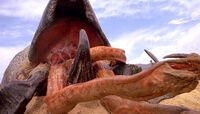
A Graboid extends its three, prehensile tongues
Graboids possess three elongated, muscular tentacles, each capable of extending up to ten feet. These appendages, normally retracted within the Graboid's throat, were initially misidentified as the primary creatures themselves. The Graboid's common name is derived from these tentacles, which are used to capture and consume prey.
Each tentacle is equipped with a mouth, teeth, and horn-like projections. Beyond their predatory function, these tentacles serve as sensory organs, detecting subtle vibrations and exploring the environment. The mouths on the tentacles contain taste receptors, allowing the Graboid to assess the potential nutritional value of its prey before ingestion.
While the tentacles may exhibit independent movement, they are ultimately extensions of the Graboid's central nervous system. Typically, prey is swallowed whole, but in certain circumstances, the Graboid may dismember larger prey, as demonstrated in the original film and Tremors 4. This behavior suggests a strategic adaptation to optimize energy intake and minimize risk.
The Graboid's metabolism appears to be relatively slow, as evidenced by the infrequent excretion observed in the series. This adaptation may be linked to its subterranean lifestyle and the limited availability of food sources.
A Graboid's hide is thick and leathery, with a rough, pebbly texture, giving them a reptilian appearance (though they are not reptiles). This makes them very hard to kill with anything short of saturation bombing or large-bore rounds, usually from guns designed for large animals such as elephants and buffalo. Graboids possess immense physical strength, able to topple over mobile homes, tow along with an object heavy as a pickup truck without slowing down, smash through brick walls and pull an entire station wagon underground. Encircling their bodies are short spikes, which all move in unison to push the Grabboid through the dirt (more specifically Pleistocene alluvial Soil), similar to the setae on an earthworm. Their top speed is around 15-20 mph in good loose soil. Therefore they are able to burrow faster than a human can run; a Graboid cannot catch motorized vehicles like cars or dirt bikes, as shown in Tremors 3: Back to Perfection when Jack's truck was able to outrun a Graboid. Also, it was been shown throughout the series and Tremors 4 that galloping horses can outpace Graboids. With armored head and mobile spikes working together in unison, a Graboid can "swim" through the loose soil at high speed like a shark in the water, though they are incapable of tunneling through solid rock. Graboids (and their nymph and imago forms, the Shrieker and Ass Blaster respectively) have distinctive orange blood. Graboids also have a powerful stench, which is made evident on several occasions throughout the first film. Though underplayed in the 2nd and 3rd films, the Grabboid's stench becomes a critical plot point in Tremors 4; Juan is able to identify the Graboids as being the unseen killers in the silver mines where they are small and jump from the ground extremely fast with a hard shell on their back, hunting by sound, shedding their shells and growing to become matured Graboids later in the film due to them sharing the same vile odor. The Graboids' greatest weakness is that it is unable to tell the terrain of the environment it is in before it's too late, which is demonstrated when Earl and Val trick one into running into a concrete wall, and when Val tricks Stumpy into running off of a cliff.
For obvious reasons, it has been all but impossible to directly observe the creature underground; observations of the surface soil above a Graboid's route, however, show that such soil is sometimes humped erratically, producing a series of rises and falls rather than a continuous ridge. This disturbance of the ground is consistent with a writhing, flexing mode of travel. Furthermore, when a Graboid surfaces, it often does so while turning its head or body in a circular motion, supporting the corkscrew theory of locomotion.
The Graboid appears to respirate the same nitrogen-oxygen atmosphere as other terrestrial animals. Witnesses have heard Grabboids sometimes expel blasts of air. This implies that Graboid's possess lungs. Whether these lungs resemble vertebrate lungs is unknown. On a related topic, the Graboid, Shrieker and Ass Blaster all have closed circulatory systems; their reddish-orange blood has been well-documented. This suggests that they possess a cardiopulmonary system, a heat pump, and an oxygen-based blood-transport system.
Metabolism[]
The Graboid would seem to require astonishing levels of energy to propel its prodigious bulk underground faster than a human can run above ground, yet it does so almost routinely when pursuing prey. It is possible that the Graboid spends most of its time in a torpid or dormant state to recover from these short, intense bursts of activity.
The Shriekers' rapid self-replication and the Ass Blaster's ability to generate volatile chemicals capable of launching it skyward suggest extremely efficient metabolisms. Like the Graboid, however, these creatures appear to need rest while digesting food and after prolonged expenditures of energy. Supporting this theory is the observation that, when fully fed, an Ass Blaster collapses into a "food coma" in order to digest and to regain its equilibrium.
Curiously, in addition to its feats of speed and its ability to digest large prey, the Graboid has even shown an occasional willingness to eat metal. One of the creatures swallowed a large metal drum containing Burt Gummer, and there is also a report of Graboids attacking a station wagon. Did the Graboids involved in these incidents attack because their bodies are capable of deriving useful nutrients from inorganic objects? Or, as is considered more likely, did the car's vibrations (or Gummer's movements inside the barrel) mislead the Graboids into thinking they had found living prey?
It is possible that the Graboid's underground life gives it access to elements or chemicals that "supercharge" its digestion and metabolism. Because the surface-dwelling Shrieker and Ass Blaster also show a similar level of digestive/metabolic ability, the discarded body of their parent Graboid might provide them with these required chemicals. It is also possible that this ability is simply inherent in all three species. Regardless, it remains one of the most impressive aspects of their physiology.
Hunting and Intelligence[]
Graboids are shown to be ravenous carnivores, always on the hunt for food. Indiscriminate eaters, their diet includes but is not limited to sheep, cattle, horses, donkeys, coyotes, and even humans. They are known to be cannibalistic when the opportunity presents itself; El Blanco consumed an Ass Blaster in Tremors 3. Lacking eyes or a nose, they're shown to hunt by sensing seismic vibrations, which are produced by sounds and movements. Because they are unable to tell the difference between edible and inedible vibration sources they adopt a policy of "eat first, ask questions later," simply swallowing whatever sets off their vibration sensors and regurgitate anything that does not taste good. Inedible objects can be spat out with amazing force, being propelled high into the air. Due to the sensitive hearing they use for underground navigation, Graboids are so sensitive to sound they must retreat from loud explosions, which cause them great pain due to sensory overload. For the same reason, Graboids are unable to hunt during rainstorms. The scientific explanation for this is based on the fact that scientists recently learned that rain is one of the loudest sounds underwater in the ocean.
Graboids are ambush predators, preferring to sneak up on their quarry, though they are shown to chase it down with great determination. They erupt from the ground and use their tentacles to ensnare prey, pulling them into their mouth. The tentacles wrap around the prey, biting into its flesh or hooking the prey with their horn-like spikes. When the prey attempts to flee by climbing, Graboids will simply dig away the earth under the hiding place, undermining it until it collapses or sinks low enough to allow the Graboid to pluck off the hiding prey. When they are unable to break down the prey's hiding spot, the undaunted Graboids will continue circling it like sharks until it ceases making vibrations. Usually, they wait so long the prey dies of dehydration or starvation, i.e. several days.
Little is known about the creatures' nervous systems, but all forms of the Graboid appear to have sophisticated brains, at least as compared with other predatory animals. All Grabboids has exhibited signs of being extremely quick studies. Science cannot yet measure exactly how smart these creatures are, but they might approach the intelligence levels of such mammalian pack predators like wolves and lions. That being said Graboids are highly intelligent, possessing memory and the ability to learn. For instance, in the first Tremors movie the characters successfully killed a Graboid by having it swallow homemade dynamite. The second Graboid had apparently noticed this trap and simply regurgitated the dynamite. There are plenty of other examples, for instance when the characters escaped on a bulldozer which was too big to be toppled or undermined, the creatures simply dug a trap in its path.
In Tremors 5: Bloodlines, Burt states that the Graboid is native only to the Northern Hemisphere. At the time, he was unaware of the existence of the African species.
Communication[]
Graboids can communicate by a wide variety of clicking noises informing each other for food sources. 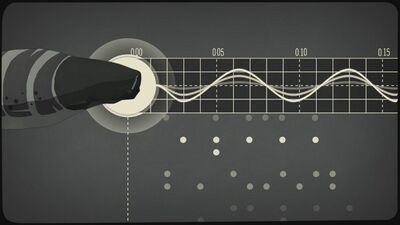
Maturation cycle[]
African Species[]
- The African species presumably has a similar life cycle to the American species, but unlike the American species, which is only seen in the Northern Hemisphere, the African species is found in the Southern Hemisphere, or at least Africa. It is unknown when this species branched off from the American species, but archaeologists find a skeleton of one, indicating that this is not a new evolution. After seeing the skeleton, Burt describes this species as longer and slimmer. While not a biologist he describes this species as more evolved and efficient, better adapted to their environment. The Shrieker stage was never seen, possibly indicating that their life cycle bypasses it all-together.
The African species' tentacles, referred to as "Grabbers", can detach from the host Graboid. They are sentient and can hunt on their own. Separated, they are fast and lethal, able to climb up rocky surfaces. However, this leaves them more vulnerable to being attacked. It is unknown how many Grabbers each African Graboid has as Tremors 5: Bloodlines features only two Graboids with multiple Grabbers appearing throughout the movie.
The African Graboid also exhibits a far more aggressive hunting behavior than American Graboids; besides simply coming up and swallowing their prey from beneath, or using their tentacles to reel them in, these Graboids can launch themselves out of the ground to its target, showing considerably more agility than the North American Graboid. Presumably, this behavior developed in response to the speed and alertness of African animals, many of which can run faster than a Graboid's top tunneling speed, and will flee at the sensation of the ground moving were a Graboid to attempt to tunnel under them. Additionally, paleontologists found evidence that this species is able to tunnel through rock by releasing formic acid from its mouth to soften rock before using its magnesium mandibles to eat through it. This would mean that the established practice of getting up on boulders or other rock formations to escape and stay out of reach would be ineffective against an African Graboid, as it could dissolve the rock until it got to the prey.
Unlike the American species, the primary driver of members of this species is shown to be the propagation of the species rather than hunting. To this end, they cooperate with any Ass Blasters to protect their nests. This level of social cooperation is greater than any seen in the American species, and could, in fact, be described as a non-exist ant. Ass-Blasters and Graboids ignored each other outright instead of working together, in one case a Graboid was known to eat an Ass-Blaster.
Unlike the American Graboids, African Graboids have a clear internal skeleton that can fossilize. American Graboids have a semi-rigid internal structure, but African Graboids have more developed internal structures more similar to some vertebrates. This likely, while not specifically stated, is a convergently evolved trait for African Graboids to better support their larger bodies, but it is unknown why and how they developed a skeleton-like structure.
Arctic Species[]
- The Arctic species appear to be the evolutionary link between the two species having traits from both, although it is believed to predate either, indicating that the Desert American species and African Species diverged from this singular species. They look and behave similar to the desert North American species, but have traits of the African variant, such as breaching. Also as with the African variety, they have no Shriekers and develop Ass Blasters, but as the desert American Graboids, there is no apparent cooperation between Ass Blasters and Graboids.
It is unknown if the Arctic Graboids have a more developed skeleton structure like their African relatives. Most likely not if African Graboids did convergently evolve their skeletons rather than being an ancestral trait lost in only American Graboids.
Burt believes they may be modified in some way to be bio-weapons, although, given his normal levels of paranoia, this wasn't likely though Mr. Cutts became interested in the idea.
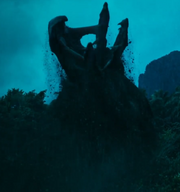
Genetically Altered Graboid in Tremors: Shrieker Island.
Oceanic Species
This species is named after it's aquatic nature, having been able to swim to various islands. They are the result of Bill genetically engineering Graboid's for hunting. The Shriekers are the only other stage these Graboids go through during the life cycle, as no Dirt Dragons or Ass Blasters can be found on the island. They appear to be a hybrid of the American, African, and Arctic variants.
Hatching and Science[]
Graboids hatch from eggs that can lay dormant for at least 300 years, possibly even longer. Abnormal heating (geothermal or radiation) of the soil around a Graboid egg can accelerate its gestation and cause it to hatch sooner.
Once hatched, Graboid worms grow very swiftly into 30-foot-long, sightless, underground eating machines that hunt via their extra-sensitive hearing. They can zero in unerringly on the slightest movement or vibration. It's also worth noting that many people who have survived encounters with Grabboids have reported that one can smell the stench of a Graboid long before one actually sees its eel-like hunting appendages.
In the Tremors: The Series episode Shriek and Destroy it is stated that scientists believe that the Graboid species is now in a hatching cycle which is why so many eggs are now hatching and Graboids are popping up. Besides the Graboids seen in Perfection, Mexico and Africa which hatched in clusters, Graboids are generally seen hatching alone.
In Tremors 5: Bloodlines, the African breed of Graboid is shown to be very protective of its eggs and focused on getting them to hatch and propagate the species. To this end, they have been seen to work side-by-side with Ass Blasters. The American breed doesn't show this behavior with their eggs however, as the Ass Blaster is one to lay the eggs, but none have ever lived to do so with humans to observe them. So it's not known if Ass Blasters, in general, nurture the eggs.
SAFETY TIP:[]
When in an area infested with Graboids, it is important to remain absolutely motionless and silent. If you are in a stopped motor vehicle, do not let the engine idle, and be certain to turn off car stereos and any other sound-producing devices, such as a portable CD or tape player with headphones. If you are in an area with Graboids do not jump on a pogo stick, use a jackhammer, use a tamper, or use a drilling rig Graboids will be attracted to the vibrations and will eat you.
Abilities[]
Graboids have proven to be deadly underground predators.
Strength & Combat: Graboids, given their immense size, possess considerable physical strength. They are capable of overpowering small vehicles and subduing large animals such as horses with their powerful, serpentine tentacles.
In combat, Graboids primarily rely on their formidable jaws and tentacles. Their jaws, capable of crushing a dirt bike and its rider, deliver a devastating bite. The tentacles, equipped with sharp teeth, are used to grasp and subdue prey, as well as to manipulate objects in their environment.
Burrowing: Graboids are subterranean creatures, spending their lives tunneling through the earth. They create intricate underground networks, providing them with both shelter and hunting grounds, effectively concealing their presence from both humans and potential prey.
Speed & Agility: Graboids exhibit remarkable speed and agility, capable of reaching speeds of 15 to 20 mph. This allows them to rapidly pursue prey, making quick turns and changes in direction.
Intelligence: Graboids exhibit a surprising level of intelligence. They understand basic tactics, such as exploiting human tendencies to seek higher ground during attacks. They can patiently wait for prey to descend, setting up ambushes and traps. Additionally, they can devise complex strategies, such as creating sinkholes to immobilize large vehicles. Older, more experienced Graboids, like El Blanco, demonstrate even greater cognitive abilities, forming alliances and recognizing potential threats.
Vibration Sensor: Graboids possess a highly developed sense of vibration, allowing them to detect and track prey from a distance. This acute sensory ability enables them to pinpoint the location of potential victims with precision.
Endurance & Stamina: Their endurance is actual is pretty high as it took many gunshots to kill one Graboid that attack Burt basement as they use a variety of guns to kill it. Though over time they learn more as their endurance will not work on weapons that Burt will use to kill them more easily such one type of gun that was used on Graboid in the series that will blow it up with one shot. Though their endurance was also proved that Graboids will not be able to survive as full speed to go through a concrete wall will kill itself. Their stamina is very high as they can chase prey for a long period of time.
Hunting: Its hunting style has proven to be quite solitary but can work in packs if needed to such as more of the variety of prey it's on the ground. Its true hunting style is ambush as they will hunt prey by waiting for fir the target to make loud noises of vibration to attack. Though they can work as a team to make plans to get more prey by breaking down small houses or sheds proven in Tremors.
Maturation: As it has the ability to go into other forms as they can explode into the stage of the transformation into Shriekers to pop out at least nearly 6 then they turn into the next to gain the legs with heat sensor and final stage of the life cycle the Ass Blaster to take air.
Grabbers: Its special feature of a Graboid as these are tongs are about six feet long as these are snake-like as it's able to grab around prey that is large like a horse to bring it down. It can use the snake-like tongs to bites its prey to hold and weaken the prey.
Parasitic Infection: The Graboid houses a very deadly parasite (contracted by other lifeforms by being consumed by the Graboid but escaping before being digested) which under most circumstances will kill its host in 48 hours but can lie dormant for up to 20 years in a host ( exemplified in the case of Burt Gummer) will cause the host to become slower, weaker, causes intense headaches, as well as hallucinations and unconsciousness. The only known way to cure the host is to remove antibodies from a gland in the back of the throat of a Graboid, which must be alive at the time of the extraction for said antibodies to be viable.
Folklore[]
"Spirit Demons from dark places, eating the souls of those who live in the light"
Tecopa, Tremors 4: The Legend Begins
Based on the quote above it could be summarized that besides Speculations in the Department of the Interior Report.[4]
The Graboids seemed to have surfaced enough times in the past thousand years (possibly during an earlier hatching cycle) for them to pass into the traditions of local native American tribes as Tecopa asserts, he seems to ascribe the Graboids' predations to being these creatures of legend. This could possibly mean that they avoided the valley that became Rejection and is now Perfection.
During Tremors 5: Bloodlines, a cave is shown with caveman paintings of Graboids, showing that the species had been active in caveman times as well, enough to have paintings made of them. They have also been shown to have been active at presumably some later point in the past but close enough to the present to leave behind a skeleton as one is dug up by archeologists not far from the cave with the paintings. Nandi also states that her ancestors hunted what they called Lightning Birds but were actually Ass Blasters
Origins[]
For the supposed evolution of the Graboid check out Graboid Evolution.
From where or what the Graboids originate is intentionally kept very vague; the creators of the film were unconcerned with this detail, offering no explanation as to where the Graboids came from in the original film (wanting to avoid the typical clichés of the monster movie genre). The main characters even satirize this convention by attempting to guess where they came from—outer space, nuclear mutations, genetic engineering, and prehistory are all offered up as possible explanations.
The answer was revealed in Tremors 2, when a fossil Graboid spike was discovered and dated back to the Precambrian - the Graboids are apparently from Earth or have at least existed on Earth for a very long time, possibly over a billion years, thus making them "the oldest life-form on the planet". Strangely, during Precambrian life on Earth was mostly unicellular and there was no prey large enough for Graboids to eat. A write-up by the Sci-Fi channel for Tremors: The Series rectified this by saying the fossil was incorrectly dated and actually from the Devonian period, though they don't rule out a possible extraterrestrial origin.
Though they resemble worms, in Tremors 3 the United States Department of the Interior calls them "desert reptilians". Later an elaborate write-up on the SciFi channel's Tremors: The Series homepage (written as an in-universe Department of the Interior report) classified them as cephalopods based on their intelligence, beaks and tentacles.[5] This same promotional material gives the Graboids and their later forms their scientific names and also labeling them "the oldest species on Earth."
As a result of the name of the series, "Tremors", many fans colloquially (and incorrectly) refer to the Graboid beasts as "tremors". The result of this was that on-screen in Tremors 3, a tourist erroneously refers to one as a "tremor", only to be corrected by the character "Desert Jack" who replies, "They're called Graboids!"
In Tremors 5: Bloodlines, the second breed of Graboid is shown to have evolved at some point. It is unknown when this happened, but it is not a recent occurrence as archeologists discovered a skeleton belonging to this breed in Africa where the breed seems to be localized. This one has evolved to be more adapted to their environments such as detachable tentacles (called Grabbers) and nocturnal Ass Blasters.
Notable Individuals[]
- The albino Graboid, El Blanco.
- And the longest surviving worm in the first movie, who grabbed Val and Earl's truck and lost a tongue trying to keep the truck still but loses a tongue at the end; He also is responsible for killing Chang and testing the Houses, such as the Chang's Store, was nicknamed Stumpy. Killed when Val tricks him into burrowing through a cliff.
- A Graboid in Mexico who was smart enough to bite/snag the chain hanging off of the end of Earl and Grady's truck and ended up taking them on a joy ride. This ended when the chain broke upon a rock right just before the Graboid was set to pull them into a boulder. This Graboid also ate a radio Earl and Grady placed on the ground, making a similar characteristic to the crocodile from Peter Pan. Later Burt would report the duo that he had killed a Graboid with a chain in its the mouth, Prompting Grady to shout "that one was ours".
- There was a dead mounted/stuffed Graboid in Burt's den. This is the Graboid Heather and he killed when it attacked their basement.
- A Graboid in the desert surrounding the town of Toluca, NM learned to recognize the vibrations from Cecil Carr's IGC dish & figured out that people would regularly come by to maintain it, giving it a steady food supply in A Little Paranoia Among the Friends. Killed by Tyler Reed with Burt's .50 caliber rifle.
- In Tremors 5: Bloodlines a Graboid appeared that was known simply as The Queen Bitch. She acted as the leader of a nest of Graboids and Ass Blasters, but were of a different more evolved breed apparently native to Africa. The Queen Bitch worked to preserve the bloodline of the African Graboids by protecting her nest and the eggs within. After the destruction of the nest and the remaining Graboid and Ass Blasters, the Queen Bitch attacked a nearby village where a single egg remained. The villagers, Burt and Travis Welker lured her into a lightning trap where a grounded lightning strike forced her to the surface where Burt and two local villagers Nyala and Lucia opened fire on her. A second lightning strike went straight down her throat, causing her to explode and killing her.
Notable Incidents[]
- Rejection Graboid Incursion of 1889
- Perfection Graboid Incursion of 1989
- Chipas, Mexico Graboid Incursion of 1996
- El Chaco, Argentina Graboid Incursion of 2001
- Perfection Graboid Incursion of 2001
- Juniper, Arizona Graboid Incursion of 2003
- Toluca, New Mexico Graboid Incursion of 2003
- African Graboid Incursion of 2015
Gallery[]
For additional graboid images and a discussion on the graboid design process, visit [6] and [7].
Appearances[]
- Tremors
- Tremors 2: Aftershocks (Briefly)
- Tremors 3: Back to Perfection
- Tremors 4: The Legend Begins (As "Rejection")
- Tremors: The Series
- Tremors 5: Bloodlines (North American species briefly)
- Tremors: A Cold Day In Hell
- Tremors: Shrieker Island
References[]
- ↑ 1.0 1.1 S. S. Wilson (writer), Brent Maddock (writer), [Ron Underwood]] (director); Tremors DVD. Universal Home Entertaiment.
- ↑ https://www.imdb.com/tt100814/fullcredits
- ↑ Tremors 4 audio commentary, Tremors Attack Pack
- ↑ http://web.archive.org/web/20040623151536/www.scifi.com/tremors/monsters/analysis/07_mythology.html
- ↑ http://web.archive.org/web/20040618063020/http://www.scifi.com/tremors/monsters/analysis/06_taxonomy.html
- ↑ Monster Legacy, "Subterranean Terror — Part I: Tremors". http://monsterlegacy.wordpress.com/2014/09/20/subterranean-terror-part-i-tremors/
- ↑ Monster Legacy. "Monster Gallery: Tremors (1990)". http://monsterlegacy.wordpress.com/2014/09/20/monster-gallery-tremors-1990/

